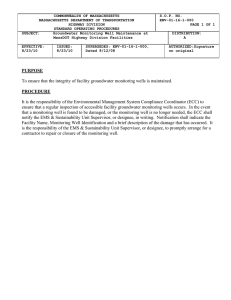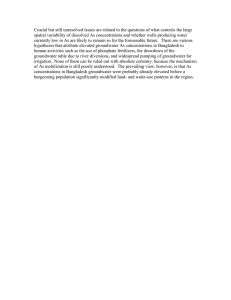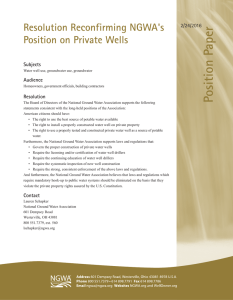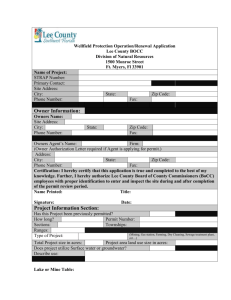Chapter 14 Ground Water Study Guide Zone of Sinkholes and
advertisement
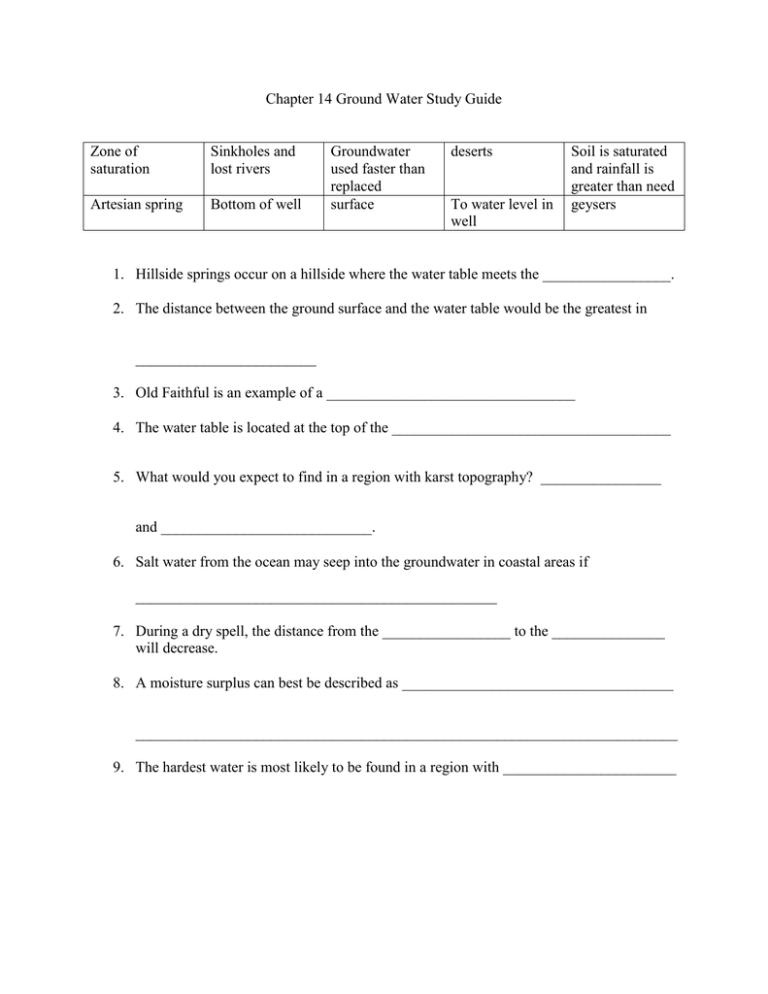
Chapter 14 Ground Water Study Guide Zone of saturation Sinkholes and lost rivers Artesian spring Bottom of well Groundwater used faster than replaced surface deserts To water level in well Soil is saturated and rainfall is greater than need geysers 1. Hillside springs occur on a hillside where the water table meets the _________________. 2. The distance between the ground surface and the water table would be the greatest in ________________________ 3. Old Faithful is an example of a _________________________________ 4. The water table is located at the top of the _____________________________________ 5. What would you expect to find in a region with karst topography? ________________ and ____________________________. 6. Salt water from the ocean may seep into the groundwater in coastal areas if ________________________________________________ 7. During a dry spell, the distance from the _________________ to the _______________ will decrease. 8. A moisture surplus can best be described as ____________________________________ ________________________________________________________________________ 9. The hardest water is most likely to be found in a region with _______________________ Uncemented sand depleted Percentage of volume that is pore space Zone of saturation aquifers limestone silt Groundwater removal cobbles Mineral deposits 10. _________________________________ can cause subsidence. 11. _________________________ has very low permeability. 12. _________________________ and _______________ would make the best aquifer. 13. _____________________________forms when groundwater that contains dissolved minerals cools or evaporates. 14. Permeable layers of rock and sediment that store and carry groundwater to wells are called ____________________________________ 15. Porosity can be defined as __________________________________________________ 16. In what type of bedrock would you most expect to find caverns? ___________________ 17. A water deficit occurs when the need for moisture is greater than rainfall and water storage is _________________________________. 18. The area immediately below the water table is the ____________________________ geysers Water table will drop Water table precipitation Very small pore spaces carbonate deposits formed by dripping water Sources of fresh water evaporation gravity Direction of movement Average elevation of permanent snow They can connect directly to the water table limestone 19. Most water leaves the ocean through evaporation and returns to the ocean through ____________________________________________________ 20. Rivers, springs, and aquifers are all ______________________________________ 21. Water moves more slowly through clay than humus because clay has _____________________________ 22. The three wells shown provide water for a growing city. What is the most likely effect on the system if six new wells are brought into production as the population increases? ________________________________________________________________________ 23. A slight increase in the amount of solar energy that reaches the Earth will cause an immediate increase in ______________________________________ 24. During droughts, lack of rain can lead to wells drying up. This is because the drought has lowered the ____________________________ 25. Ocean → Evaporation → Condensation ? What would come next in the water cycle? ______________________________________ 26. Sinkholes associated with natural processes are characteristic of what type of bedrock? ___________________________ 27. In karst regions, caves are carved by the flow of water through limestone bedrock. How do the stalagmites and stalactites in the caves develop? ______________________________________________________________________________ 28. What can result when underground water is heated by hot igneous rock? _____________ 29. According to the above diagram, the water supply will be most consistent in well number ________ 30. 31. 32. The picture above shows that one of the main pollution problems associated with sinkholes is that ____________________________________________________ 33. This picture shows a simple well that was dug down to the groundwater. What probably caused the lower level of groundwater, known as a “cone of depression,” around the well? F The weight of the atmosphere presses down on the groundwater in the well. G The ground below the well acts as a vacuum sucking out the water. H Gravity pulls down the water beneath the well. J As water is drawn from the well, it takes time for the groundwater to percolate through the soil and restore the level. 34. A glacier moves under the force of A. Mass B. Momemtum C. Compaction D. Gravity 35. What is the snow line? A. Lowest elevation at which snow falls B. Lowest elevation of permanent snow in winter C. Lowest elevation of permanent snow in summer D. Average elevation of permanent snow 36. Striations provide an indication of a glacier’s A. Direction of movement B. Rate of melting C. Depth D. age


